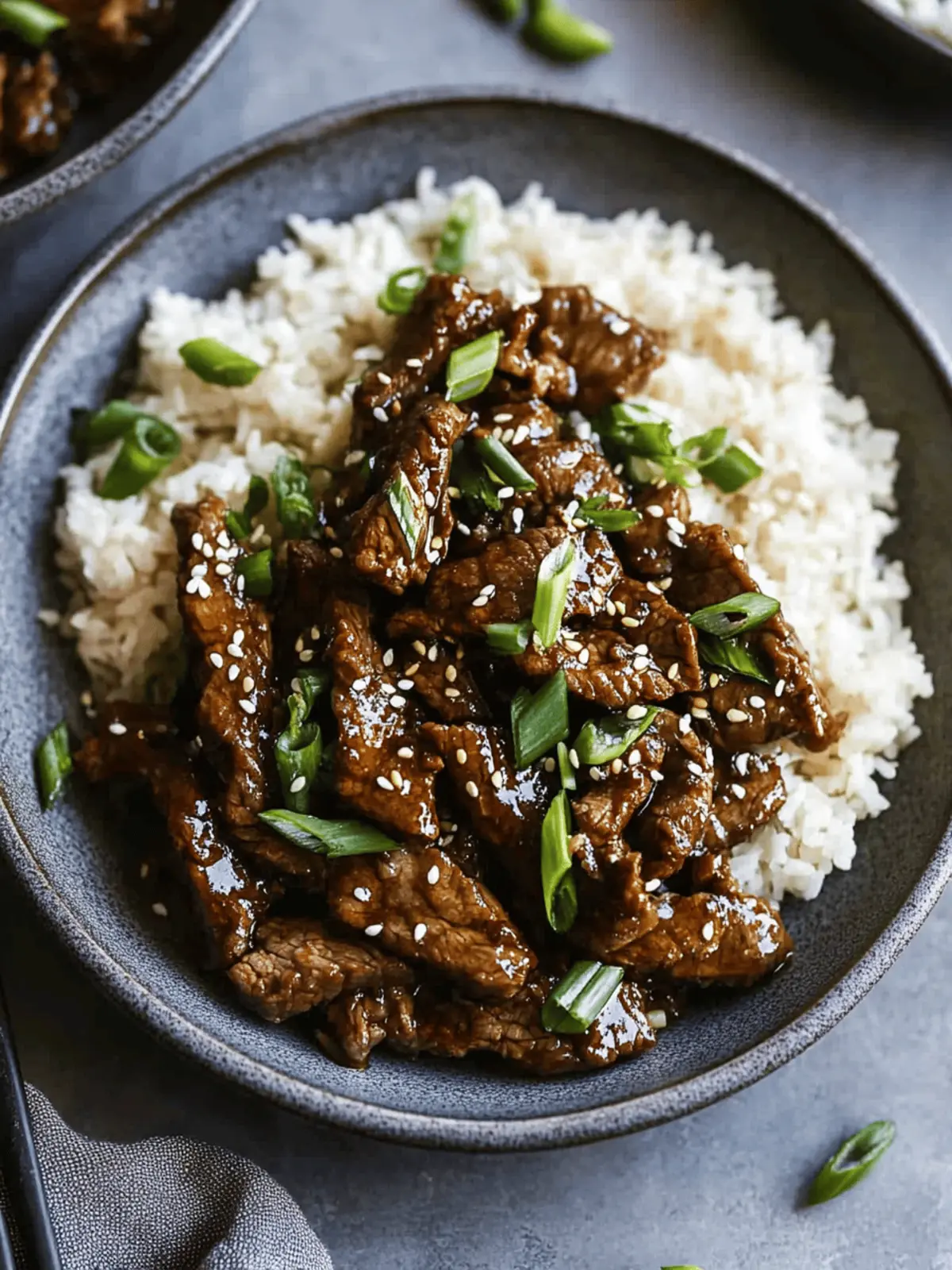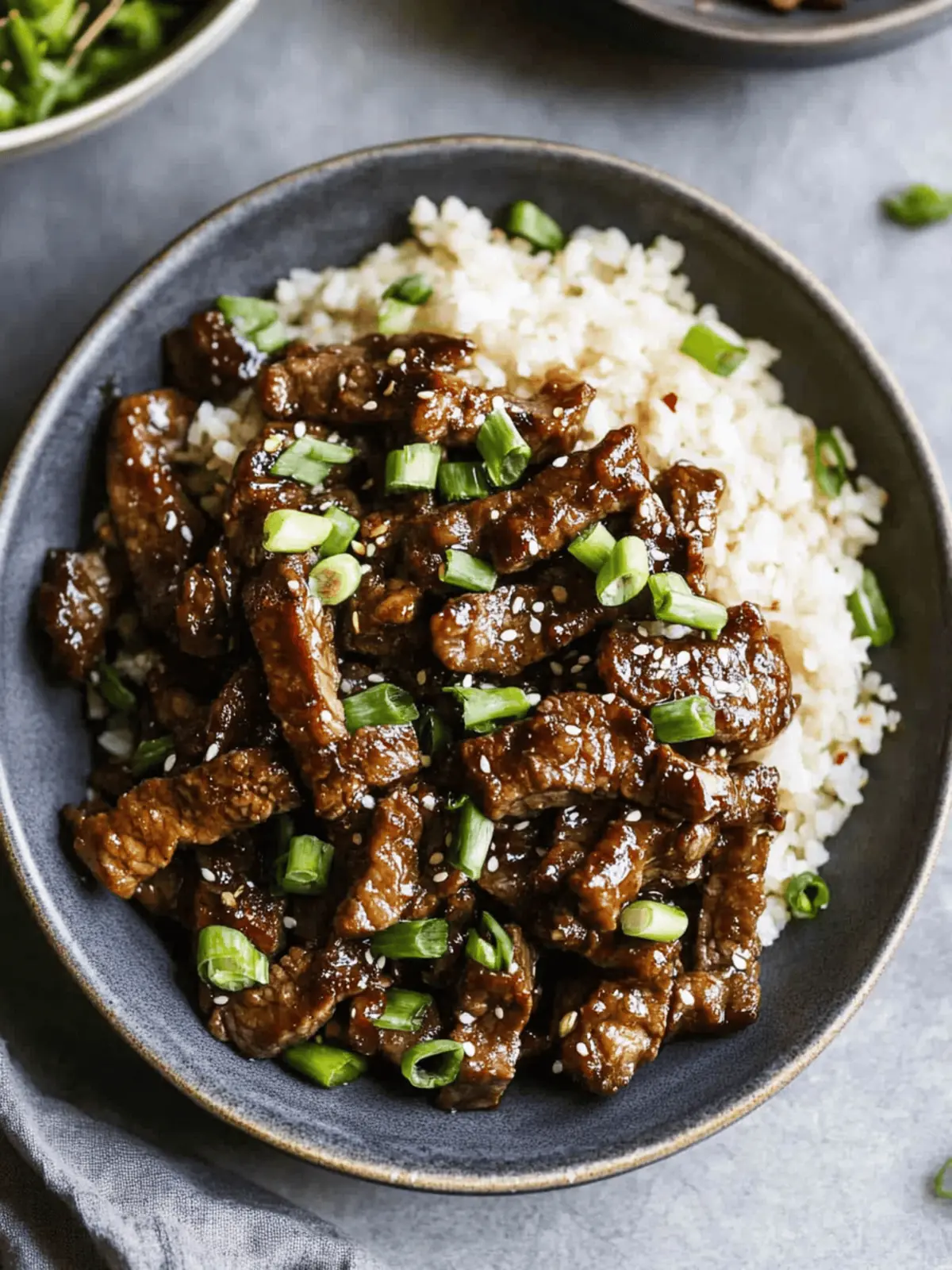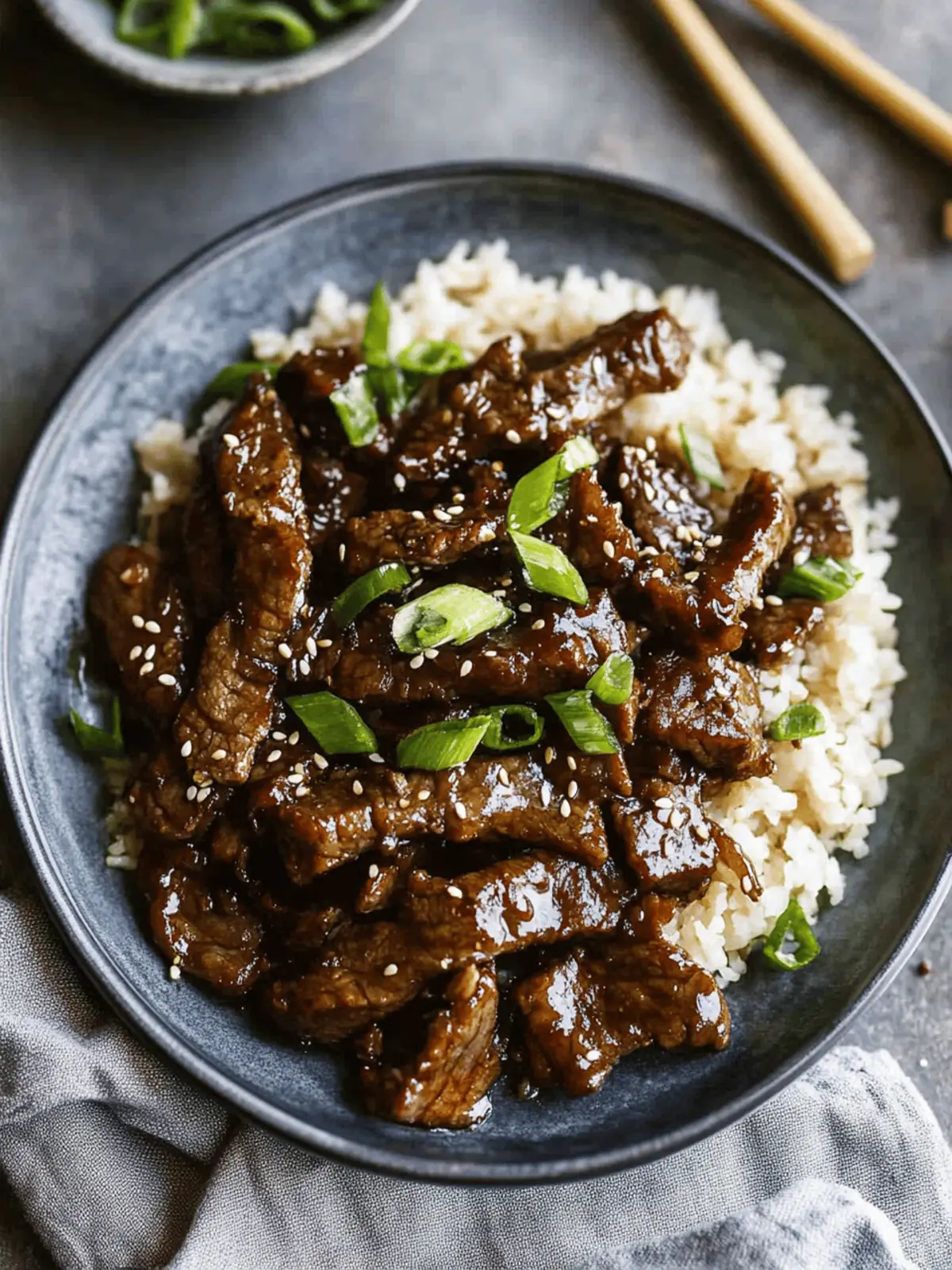The moment the rich, savory aroma of Mongolian Beef fills the air, you know dinner is about to be something special. Picture this: tender strips of beef, perfectly coated in a glossy ginger and garlic sauce, served hot over a bed of fluffy rice. I stumbled upon this delightful dish during one of those busy weeknights when takeout just wouldn’t cut it. With just 30 minutes to spare, I was determined to whip up something quicker and far more satisfying than a fast food fix.
This Easy Mongolian Beef recipe not only delivers on flavor but also packs a protein punch, making it a fantastic choice for anyone looking to satisfy those cravings without the hassle. And the best part? With simple adjustments, it can even cater to gluten-free diets! Join me as we dive into this crowd-pleasing meal that is destined to bring joy to your dinner table, all without breaking a sweat. Let’s get cooking!
Why is Mongolian Beef a Must-Try?
Simplicity at its core: This recipe comes together in just 30 minutes, making it an ideal choice for busy weeknights.
Savory and satisfying: Each bite bursts with rich flavors from the ginger and garlic, complemented by tender beef.
Versatile and accommodating: Feel free to swap out proteins or add your favorite veggies for a personalized touch!
Crowd-pleasing appeal: This dish is sure to impress family and guests alike, leaving everyone asking for seconds.
Health-conscious choice: Packed with protein, Mongolian Beef makes for a filling meal that perfectly balances taste and nutrition.
Who knew homemade could be this easy and delicious? Enjoy a gourmet takeout experience from the comfort of your home!
Mongolian Beef Ingredients
For the Beef
• Flank Steak – The primary protein providing tenderness and flavor; can also use sirloin or skirt steak for similar results.
• Cornstarch – Coats the beef for a crispy texture; consider arrowroot powder for a gluten-free option.
For the Sauce
• Vegetable or Canola Oil – Used for frying the beef; peanut oil can offer added flavor.
• Low-Sodium Soy Sauce – Adds umami depth; swap with Tamari for a gluten-free recipe.
• Water – Thin the sauce for a smooth consistency; no substitutions required.
• Light Brown Sugar – Balances the saltiness of the soy sauce; coconut sugar works for a lower glycemic index.
• Freshly Grated Ginger – Infuses warmth and complexity; ground ginger can be used in a pinch.
• Garlic (minced) – Contributes aromatic flavor; replace with garlic powder if fresh is unavailable.
• Cornstarch + Water (Slurry) – Required to thicken the sauce for a glossy finish.
For Garnish and Serving
• Green Onion (chopped) – Adds freshness; can substitute with chives or omit if preferred.
• Cooked Rice – Serves as the perfect base; cauliflower rice is a great low-carb alternative.
Get ready to savor the rich, savory goodness of this Mongolian Beef recipe that will have everyone coming back for more!
How to Make Mongolian Beef
-
Prepare the Beef: Slice the flank steak thinly against the grain, making sure the slices are even for quick cooking. Toss the beef with cornstarch until evenly coated.
-
Cook the Beef: Heat a generous amount of vegetable or canola oil in a large pan or wok over medium-high heat. Fry the beef in small batches for about 30 seconds per side until nicely browned. Remove to a plate once done.
-
Make the Sauce: In the same pan, sauté the freshly grated ginger and minced garlic for about 20 seconds until fragrant. Whisk together the soy sauce, water, light brown sugar, and cornstarch slurry, then pour it into the pan. Simmer for around 2 minutes until slightly thickened.
-
Combine and Serve: Add the cooked beef back to the pan, tossing it in the rich sauce until heated through. Stir in the chopped green onions and serve immediately over a bed of hot cooked rice or cauliflower rice for a low-carb option.
Optional: Top with sesame seeds for an extra crunch and flavor!
Exact quantities are listed in the recipe card below.
What to Serve with Mongolian Beef?
Imagine a vibrant table set with dishes that beautifully complement the savory goodness of Mongolian Beef, creating a feast for both the eyes and the palate.
-
Steamed Jasmine Rice: The fluffy grains soak up the rich sauce, making it an essential pairing to balance the bold flavors of the beef.
-
Garlic Green Beans: Cooked to crisp perfection, these tender green beans add a refreshing crunch and a hint of garlic that ties the meal together nicely.
-
Stir-Fried Broccoli: With its bright color and slightly charred flavor, this vegetable brings a delightful contrast in texture and nutrition to the plate.
-
Crispy Spring Rolls: Perfect as an appetizer, these crunchy rolls filled with veggies or shrimp offer a satisfying bite that pairs well with the meal’s savory notes.
-
Sesame Noodles: Served chilled or warm, the nutty flavor of sesame in the noodles pairs beautifully with the richness of the Mongolian Beef, turning your meal into a culinary adventure.
-
Chilled Cucumber Salad: A refreshing side dish that balances the heat, this salad with a vinegar dressing cools the palate while adding a burst of freshness.
-
Mango Sticky Rice: For dessert, this sweet treat adds a delightful fruity finish, with its creamy coconut rice contrasting beautifully with the rich flavors of the main course.
-
Chardonnay: A glass of chilled Chardonnay enhances the meal’s flavors, its crisp acidity beautifully cutting through the richness of Mongolian Beef.
Make Ahead Options
These Easy Mongolian Beef dishes are perfect for meal prep enthusiasts looking to save time during busy weeknights! You can prepare the sauce up to 3 days in advance by whisking together the soy sauce, water, brown sugar, and cornstarch slurry, storing it in an airtight container in the refrigerator. Additionally, slice the flank steak and toss it with cornstarch up to 24 hours ahead to enhance tenderness. When you’re ready to serve, simply heat the oil in a pan, cook the beef, add the sauce, and toss in the green onions. This way, you’ll enjoy the same delicious, savory experience with minimal effort and maximum convenience!
Storage Tips for Mongolian Beef
• Fridge: Store cooked Mongolian Beef in an airtight container for up to 3 days. This helps retain its rich flavors while preventing any unwanted odors from the fridge.
• Freezer: For longer storage, freeze portions of Mongolian Beef in a freezer-safe container for up to 3 months. Ensure to cool completely before packing to avoid freezer burn.
• Reheating: To reheat, thaw overnight in the fridge and warm gently in a pan over low heat. Add a splash of water or broth to keep the beef moist and flavorful.
• Make-Ahead: Prepare the sauce in advance and refrigerate for quick assembly during busy evenings. Just make sure to stir well before using in your Mongolian Beef recipe!
Expert Tips for Mongolian Beef
• Slice Against the Grain: Ensure to slice the flank steak against the grain for tenderness, as this helps achieve the perfect melt-in-your-mouth texture.
• Avoid Overcrowding: When frying the beef, working in small batches prevents overcrowding, allowing the meat to sear nicely instead of steaming.
• Adjust the Sweetness: Taste and adjust the amount of light brown sugar based on your preference; using less could help balance out saltiness, especially with regular soy sauce.
• Use Fresh Ingredients: For the best flavor, always opt for freshly grated ginger and minced garlic if possible; they make a significant difference in the richness of the sauce.
• Thicken Wisely: If the sauce is too thin after simmering, the cornstarch slurry can be gradually added in more until you reach the desired consistency.
• Experiment with Veggies: Feel free to add vibrant vegetables like broccoli or bell peppers for added nutrients and color in your Mongolian Beef!
Mongolian Beef Variations
Feel free to explore these variations and make this dish your own with delightful twists!
-
Protein Swap: Use chicken or tofu instead of beef for a lighter option that still packs a punch.
-
Veggie Boost: Add colorful bell peppers or crispy broccoli to the stir-fry for extra nutrition and vibrant color. They bring a delightful crunch and flavor contrast.
-
Lower Sugar: Adjust sweetness by using less brown sugar or experiment with maple syrup for a different flavor profile.
-
Gluten-Free Twist: Substitute low-sodium soy sauce with tamari to make this dish entirely gluten-free without sacrificing flavor. It’s a simple change that makes a big difference!
-
Spicy Kick: Add red pepper flakes or a dash of sriracha to the sauce for heat that enhances the overall flavor.
-
Noodle Variation: Serve the Mongolian Beef over rice noodles instead of traditional rice for a fun twist that’s equally satisfying.
-
Herb Infusion: Toss in fresh basil or cilantro just before serving for an aromatic finish that brightens the dish immensely.
-
Crunch Factor: Top with toasted sesame seeds or crushed peanuts for an added crunchy texture and nutty flavor that complements the dish beautifully.
Mongolian Beef Recipe FAQs
How can I choose the best flank steak?
Absolutely! When selecting flank steak, look for pieces with a bright red color and minimal dark spots. The meat should feel firm to the touch and have a good amount of marbling for added flavor. Avoid steaks that appear gray or have excessive dark spots, as these could indicate spoilage. For the best flavor, I recommend choosing cuts that are about 1 to 1.5 inches thick.
What’s the best way to store leftovers of Mongolian Beef?
Cooked Mongolian Beef can be safely stored in an airtight container in the refrigerator for up to 3 days. It’s essential to let the dish cool completely before sealing it to prevent condensation, which can lead to sogginess. If you’re planning to have leftovers, consider placing a piece of parchment paper between the beef and the lid for extra moisture control!
Can I freeze Mongolian Beef? How do I do it?
Yes, you can! To freeze Mongolian Beef, first allow it to cool completely. Portion the beef into freezer-safe containers or resealable bags, ensuring to remove as much air as possible to prevent freezer burn. It can be stored in the freezer for up to 3 months. When you’re ready to enjoy it, thaw the beef overnight in the refrigerator and reheat gently on the stove. You may want to add a splash of water or broth to keep it juicy!
What if my sauce is too thin?
If your sauce turns out thinner than expected, don’t worry! Simply mix an additional teaspoon of cornstarch with a tablespoon of cold water to create a slurry. Gradually whisk this into your simmering sauce while stirring continuously. Allow it to cook for about 1 to 2 minutes until it thickens to your desired consistency. This method works wonders and ensures your Mongolian Beef has a luscious, glossy sauce!
Is Mongolian Beef safe for pets or specific dietary restrictions?
When preparing Mongolian Beef, be cautious about leftovers for pets! Ingredients like garlic and onion can be toxic to dogs and cats, so it’s best to avoid sharing. If you’re considering dietary restrictions, especially for gluten, simply swap the low-sodium soy sauce with Tamari, which is gluten-free. You can also make substitutions for those with sugar sensitivities by using coconut sugar instead of brown sugar!
Can I add vegetables to my Mongolian Beef?
Very much! Adding vegetables is a fantastic way to enhance the flavor and nutrition of your dish! Broccoli, bell peppers, or snap peas are excellent choices that pair wonderfully with the sauce. Simply toss them in after the ginger and garlic but before adding the sauce, allowing them to cook slightly until tender yet still vibrant. Enjoying a colorful plate adds an inviting touch to your meal!

Quick Mongolian Beef: A Savory 30-Minute Delight
Ingredients
Equipment
Method
- Slice the flank steak thinly against the grain and toss with cornstarch until evenly coated.
- Heat vegetable or canola oil in a pan over medium-high heat. Fry the beef in batches for about 30 seconds per side.
- In the same pan, sauté ginger and minced garlic until fragrant. Whisk together soy sauce, water, brown sugar, and cornstarch slurry and pour into the pan.
- Add cooked beef back to the pan and toss in the sauce until heated through. Stir in chopped green onions and serve over rice.








